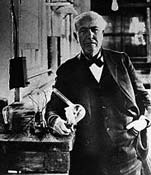爱迪生发明灯泡的故事我们自小就耳熟能详。在今天人们把他当作一个常识。不过在一百多年前,灯泡刚刚诞生的时候,谁是发明人这个问题,却引起了一场不小的争议。虽然我们现在都把爱迪生发明灯泡的说法当作盖棺定论,但事实究竟如何,恐怕只有当事人自己知道了。
 The history of the light bulb reads like a story straight out of a tabloid magazine. Contrary to what schools have taught for years, the American icon, Thomas Edison, neither invented the light bulb, nor held the first patent to the modern design of the light bulb.
The history of the light bulb reads like a story straight out of a tabloid magazine. Contrary to what schools have taught for years, the American icon, Thomas Edison, neither invented the light bulb, nor held the first patent to the modern design of the light bulb.
Apparently, we gave the esteemed Mr. Edison credit for the invention solely because he owned a power company, later known as General Electric, and a light bulb is just a bulb without a source of electricity to light it. In reality, light bulbs used as electric lights existed 50 years prior to Thomas Edison's 1879 patent date in the U.S.
Additionally, Joseph Swan, a British inventor, obtained the first patent for the same light bulb in Britain one year prior to Edison's patent date. Swan even publicly unveiled his carbon filament light bulb in New Castle, England a minimum of 10 years before Edison shocked the world with the announcement that he invented the first light bulb. Edison's light bulb, in fact, was a carbon copy of Swan's light bulb.
How do two inventors, from two different countries invent the exact same thing? Very easily, if one follows in the others footsteps. Swan's initial findings from tinkering with carbon filament electric lighting, and his preliminary designs, appeared in an article published by Scientific American. Without a doubt, Edison had access to, and eagerly read this article. Giving Mr. Edison the benefit of the doubt, and stopping short of calling him a plagiarist, we can say that he invented the light bulb by making vast improvements to Swan's published, yet unperfected designs.
Swan, however, felt quite differently, as he watched Edison line his pockets with money made from his invention, and took Edison to Court for patent infringement. The British Courts stood by their patent award for the light bulb to Swan, and Edison lost the suit. The British Courts forced Edison, as part of the settlement, to name Swan a partner in his British electric company. Eventually, Edison managed to acquire all of Swans' interest in the newly renamed Edison and Swan United Electric Company.
 Edison fared no better back home in the U.S., where the U.S. Patent Office already ruled, on October 8, 1883, that Edison's patents were invalid, because he based them upon the earlier art of a gentleman named William Sawyer. To make matters worse, Swan sold his U.S. patent rights, in June 1882, to Brush Electric Company. This chain of events stripped Edison of all patent rights to the light bulb, and left him with no hope of purchasing any.
Edison fared no better back home in the U.S., where the U.S. Patent Office already ruled, on October 8, 1883, that Edison's patents were invalid, because he based them upon the earlier art of a gentleman named William Sawyer. To make matters worse, Swan sold his U.S. patent rights, in June 1882, to Brush Electric Company. This chain of events stripped Edison of all patent rights to the light bulb, and left him with no hope of purchasing any.
Edison dusted himself off, and went into business setting up a direct current (DC) system of power distribution in New York City, and selling the light bulbs that used this electricity. The light bulb business only flickered between 1879 and 1889, until word-of-mouth advertising of lower electricity costs fanned the flame, and business boomed. Edison's client base rapidly expanded to three million customers over the span of 10 years.
Always at the center of controversy, Edison next found himself in competition with Westinghouse for the sale of the first electric chair to execute criminals to New York. Edison's chair used the DC system of electricity, while Westinghouse used the AC (alternating current) system, designed especially for it by Nickola Tesla. Both Edison and Westinghouse emphasized the humanity of electrocution and the safety of their electrical system as selling points when pitching their chairs to New York.
Edison's bid for the sale of his chair was a mere formality and a ploy to have the Westinghouse system of electricity chosen by New York for the electric chair. He endorsed the Westinghouse AC system of electricity as the system of choice to be used for the electric chair, reasoning that the public would associate the Westinghouse AC system with the killing power of the electric chair, and would see the system as unsafe for household use.
Edison made this strategic move in anticipation that the public would flock to the safety of his DC system, as he needed increased sales of the system, because of the great monetary investment he had made in the system. Edison's plan succeeded, in part, as New York did select the Westinghouse electric chair over his model.
What he could not take into account, was the fact that, unbelievably, Westinghouse never tested the chair, and the chair failed on its "Maiden Voyage." Though Edison's carefully laid plan went up in smoke, he did get the last laugh, as for years people referred to being electrocuted as being "Westinghoused," even though its chair was no longer in use.
It only took a matter of years before the public realized that the benefits of the AC system far outweighed those of the DC system. Edison's DC system took back seat, and the AC system took center stage. People in the U.S. and worldwide chose the AC system over the DC system, because AC currents deliver electricity to power lines with greater efficiency. The DC system is no longer in use today.
(来源:coolquiz.com 英语点津 Annabel 编辑)